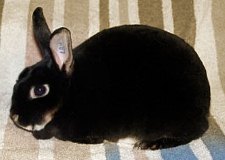Hey! Check out our NEW, more complete article on A-series Genetics Here!
Rabbit Genetics Gene Dominance For The A Gene
|
|
|
|
A Phenotype is what you see expressed (e.g., I see a black rabbit), while a genotype is what the genes are (e.g., a-a)
The A gene in its dominant form is the agouti gene, which is written as a capital “A.” It is dominant to both the “at” and the “a” gene. The agouti gene, or just “A” gene, is expressed no matter what combination it may be present in. That is, you will have an agouti rabbit phenotype whether the rabbit’s genotype is any of the following
- A-A
- A-at
- A-a

Personally, I have never seen a tan Holland lop. Let me know if you have. (Tans require two recessive wide band genes and an accumulation of rufus modifiers–sounds too complicated to me). The “at” gene is recessive to the “A” (agouti) gene, but dominant to the “a” gene. If there is even one “A” gene, you cannot have an otter or marten phenotype. An otter or marten phenotype is either “at-at” (this can be referred to as a true breeding otter/marten) or “at-a.”
Have you ever wondered whether to call a rabbit an otter or a marten? Here’s a little help. All “at” rabbits with full color (C-) are called otters:
- black otter*
- blue otter*
- chocolate otter*
- lilac otter*
- orange (or tort) otter
- chocolate orange otter
- fawn otter
- lilac fawn otter
Himalayans with the “at” gene are referred to as otter (the e gene doesn’t affect Himalayan phenotype):
- black otter Himalayan (pointed white)*
- chocolate otter Himalayan
- blue otter Himalayan
- lilac otter Himalayan
All “at” rabbits with “ee” for their extension genes are called otters (otter sable point, blue otter seal point. etc.). Only “at” rabbits with chinchilla, seal, or sable genes and a full extension gene (E) would be called martens. By applying this convention, there are only twelve martens (the rest are otters):
- black silver marten
- seal marten
- sable marten (a martenized Siamese sable)
- chocolate silver marten
- chocolate seal marten
- chocolate sable marten
- blue silver marten
- blue seal marten
- blue sable marten (a martenized smoke pearl)
- lilac silver marten
- lilac seal marten
- lilac sable marten
The “a” form of this gene – the self gene – is recessive to both the “A” gene and the “at” gene. Only one combination produces the self phenotype: “a-a.” When you see a self rabbit (for example a black tortoiseshell), you also know the genotype for the “a” gene (a-a). A self colored rabbit cannot carry an agouti (A) or tan gene (at). If it did, the agouti or tan gene would express itself and the rabbit would not be a self.
